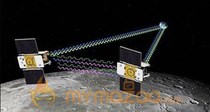The second of two NASA lunar probes on a mission to study the Moon's inner core so scientists can better understand the origins of planets went into orbit Sunday as planned, the US space agency said.
The second Gravity Recovery and Interior Laboratory (GRAIL-B) began orbiting the Moon at about 2243 GMT, according to officials at NASA's Jet Propulsion Laboratory in Pasadena, California.
GRAIL-A reached its lunar orbit on Saturday.
"NASA greets the new year with a new mission of exploration," NASA Administrator Charles Bolden said in a statement.
"The twin GRAIL spacecraft will vastly expand our knowledge of our moon and the evolution of our own planet," he said.
"We begin this year reminding people around the world that NASA does big, bold things in order to reach for new heights and reveal the unknown."
The $500-million pair of washing machine-sized satellites were launched on September 10 on a mission to map the Moon's inner core for the first time.
The spacecraft are in a near-polar elliptical orbit, traveling around the Moon in about 11.5 hours, NASA said. In the coming weeks, that orbit time will be reduced to just under two hours, it added.
Beginning in March, the two unmanned spacecraft will send radio signals that allow earth-based scientists to create a high-resolution map of the Moon's gravitational field, helping them to better understand its sub-surface features and the origins of other bodies in the solar system.
The mission should shed light on the unexplored far side of the Moon and test a hypothesis that there was once a second Moon that fused with ours.
The two spacecraft have taken three months to reach the Moon as opposed to the usual three-day journey taken by the manned Apollo missions. The longer journey allowed scientists to better test the two probes.
Scientists believe that the Moon was formed when a planet-sized object crashed into the Earth, throwing off a load of material that eventually became our planet's airless, desolate satellite.
How it heated up over time, creating a magma ocean that later crystallized, remains a mystery, despite 109 past missions to study the Moon since 1959 and the fact that 12 humans have walked on its surface.







